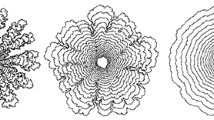Abstract
Computer-enhanced microscopy (CEM) was used to study the growth kinetics of bacterial microcolonies attached to the wall of a continuous-flow slide culture. Image processing increased effective microscope resolution and quantitated colony growth at 10 min intervals. Three growth parameters were used to determine growth rate: the time required for cell fission, the specific rate of increase in cell number, and the specific rate of increase in cell area. Growth rate was initially constant regardless of colony size, as assumed previously in deriving colonization kinetics. However, at low substrate concentrations growth rate varied depending on laminar flow velocity. Growth was flow-dependent at a glucose concentration of 100 mg/liter and flow-independent at a concentration of 1 g/liter. This indicated that the surface microenvironment became substrate-depleted in the absence of sufficient laminar flow velocities and that glucose rather than oxygen was rate limiting.
Similar content being viewed by others
References
Berg HC, Block SM (1984) A miniature flow cell designed for rapid exchange of media under high-power microscope objectives. J Gen Microbiol 130:2915–2920
Brannan DK, Caldwell DE (1984) Evaluation of a proposed surface colonization equation usingThermothrix thiopara as a model organism. Microb Ecol 8:14–21
Caldwell DE (1984) Surface colonization parameters from cell density and distribution. In: Marshall KC (ed) Microbial adhesion and aggregation. Springer-Verlag, New York, PP 125–136
Caldwell DE (1985) New developments in computer-enhanced microscopy. J Microbiol Methods 4:117–125
Caldwell DE, Germida JJ (1985) Evaluation of difference imagery for visualizing and quantitating microbial growth. Can J Microbiol 31:35–44
Caldwell DE, Lawrence JR (1986) Study of attached cells in continuous-flow slide culture. In: Wimpenny J (ed) A handbook of laboratory model systems for microbial ecosystem research. CRC Press, Chapter 6. In press
Caldwell DE, Brannan DK, Morris ME, Betlach MR (1981) Quantitation of microbial growth on surfaces. Microb Ecol 7:1–12
Caldwell DE, Kieft TL, Brannan DK (1984) Colonization of sulfide-oxygen interfaces on hot spring tufa byThermothrix thiopara. Geomicrobiol J 3:181–200
Caldwell DE, Malone JA, Kieft TL (1983) Derivation of a growth rate equation describing microbial surface colonization. Microb Ecol 9:1–6
Edwards C (1981) The microbial cell cycle. American Society for Microbiology, Washington, DC
Hirsch P (1984) Microcolony formation and consortia. In: Marshall KC (ed) Microbial adhesion and aggregation. Springer-Verlag, New York, pp 373–394
Kieft TL, Caldwell DE (1983) A computer simulation of surface microcolony formation during microbial colonization. Microb Ecol 9:7–13
Kieft TL, Caldwell DE (1984) Weathering of calcite, pyrite, and sulfur byThermothrix thiopara in a thermal spring. Geomicrobiol J 3:201–216
Kieft TL, Caldwell DE (1984) Chemostat and in situ colonization kinetics ofThermothrix thiopara on calcite and pyrite surfaces. Geomicrobiol J 3:217–229
Kjelleberg S, Hermansson M (1984) Starvation-induced effects on bacterial surface characteristics. Appl Environ Microbiol 48:497–503
Kuhn DA, Starr MP (1970) Effects of microscope illumination on bacterial development. Arch Microbiol 74:282–300
Malone JA, Caldwell DE (1983) Evaluation of two surface colonization equations in continuous culture. Microb Ecol 9:1–6
Marr AG, Painter PR, Nilson EH (1969) Growth and division of individual bacteria. In: Meadow PM, Pirt SJP (eds) Microbial growth. 19th Symposium of the Society for General Microbiology. Cambridge University Press, pp 237–268
Monod J (1950) La technique de culture continui: theorie et applications. Ann Inst Pasteur 79:390–410
Paul JH (1984) Effects of antimetabolites on the adhesion of an estuarineVibrio sp. to polystyrene. Appl Environ Microbiol 48:924–929
Perfilev BV, Gabe DR (1969) Capillary methods of investigating microorganisms. Translated by J. M. Shewan. University of Toronto Press
Vogel S (1983) Life in moving fluids: the physical biology of flow. Princeton University Press
Wardell JN, Brown CM, Ellwood DE (1980) A continuous culture study of the attachment of bacteria to surfaces. In: Berkeley RCW, Lynch JM, Melling J, Rutter PR, Vincent B (eds) Microbial adhesion to surfaces. Ellis Horwood Publishers, Chichester, UK, pp 221–230
Author information
Authors and Affiliations
Rights and permissions
About this article
Cite this article
Caldwell, D.E., Lawrence, J.R. Growth kinetics ofPseudomonas fluorescens microcolonies within the hydrodynamic boundary layers of surface microenvironments. Microb Ecol 12, 299–312 (1986). https://doi.org/10.1007/BF02011173
Issue Date:
DOI: https://doi.org/10.1007/BF02011173




